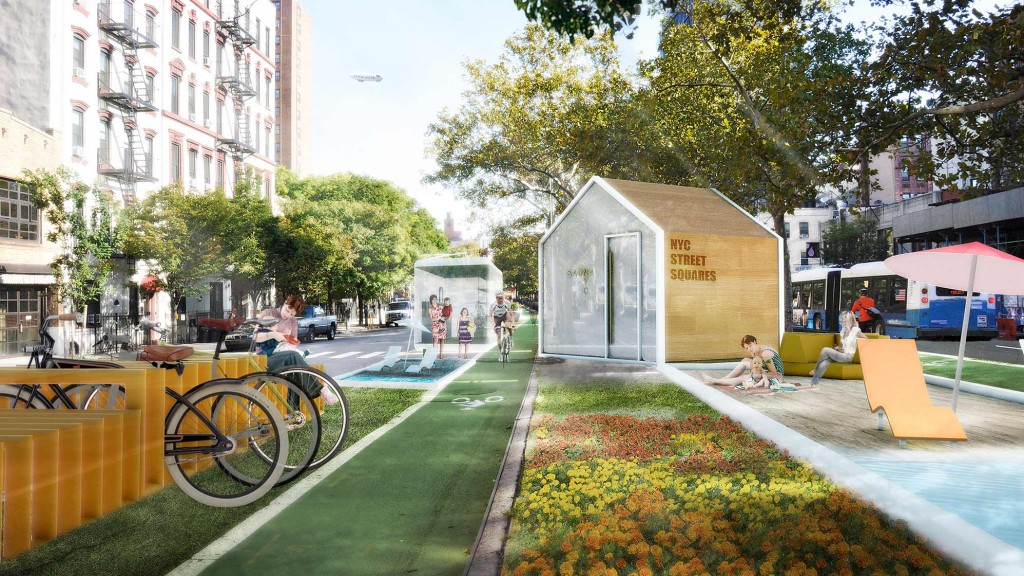Can the town square be relevant in the 21st century?
Reimagining Cities / Year 1: Redefining the Town Square
What We Did
We tasked each Gensler office with forming an internal, cross-disciplinary team to identify “town squares,” or spaces of social interaction, in their hometown that could benefit from thoughtful design intervention. These town squares, while typically urban public spaces, were not limited to physical places—some occupied virtual or even metaphorical space. The teams conducted research into the history and form of specific cities to define how and why their city works and to uncover opportunities for improvement. Each team then developed project proposals and design concepts for speculative interventions to improve the urban experience.
The Context
In 2009, 50% of the world’s population lived in a city. That amount is expected to grow to 70% by 2050, increasing the urban population by 6 million per month, every month, for 40 years. This ever-growing urban density will strain cities’ infrastructure, transit capabilities, green spaces, and housing in multiple ways and on a scale never seen before in human history. Through this initiative, our goal was to create a firm-wide focus on tackling urban problems through thoughtful, community-oriented design. This project is the first phase of a 10-year initiative—each year through 2020, our leadership will identify a new urban issue for our designers to tackle. This ongoing research creates valuable insights that can be applied to our client work and help us understand cities in a new and deeper way. As the ideas and designs generated begin to spark local discussions, some of them are resulting in real projects and opportunities to improve our cities.
The Results
The work generated by the teams across the firm ranges from frameworks—projects that seek to define a strategy for redeveloping public space through tools or guides that can be applied at various physical locations—to conceptual designs for specific physical interventions. The interventions can then be grouped into four categories that begin to define a set of fundamental approaches to addressing social and cultural health within our physical urban environment.
Civic Projects focus on the heart of our cities—physical and emotional centers. These teams are tackling issues of representation and equality, inevitably intertwining spatial design with political statements to create interventions focused on expression and civic participation.
Waterfront Projects focus on the liquid assets that are often underutilized in today’s cities. These teams are building on the intrinsic value of the natural environment within the urban context, and seek to articulate and enhance the dynamics of two converging biotypes and the emotional response that they elicit in us.
Streetscape Projects tackle the most fundamental of urban spaces and seek to reconsider a space defined by infrastructure and engineering requirements. Streets, parking lots, and highways are redefined as human spaces that perform on multiple levels. The goal of these teams is to encourage social, cultural, and community activities to coexist with our urban movement requirements.
Neighborhood Regeneration Projects seek far-reaching impact and an effect that is greater than the sum of individual interventions. These projects acknowledge that public space can profoundly influence social dynamics that extend far beyond a physical or demographic boundary.
What This Means
It’s all about the people. Although this is a global initiative that has engaged 32 Gensler offices over four continents, some common themes have emerged. Not surprisingly, the primary driver for every project was elevating the human experience. The simplest and most important lesson learned: Design is for people.
The most successful approach is a multilayered one. As designers and planners, we should avoid designing public spaces optimized around a single use. Urban spaces must work harder than ever before. The spaces we design must work on multiple levels and deliver on myriad needs to be successful.
Challenging convention creates opportunity. With each of these opportunities comes the chance to instigate a new discussion, which in turn can lead to new opportunities and innovative thinking.
What’s Next?
Each team, each office, is encouraged to pursue the work they have done to generate a larger dialogue in their professional community. This can lead to insightful professional discourse or an improved approach to project work. The results of the town square initiative should continue to bear fruit, both directly and indirectly, as this campaign moves into its second year, third year, and beyond.
Learn More
Team
Participating Gensler offices: Abu Dhabi, Austin, Atlanta, Baltimore, Bangalore, Beijing, Boston, Charlotte, Chicago, Dallas, Denver, Detroit, Houston, Las Vegas, London, Los Angeles, Minneapolis, Morristown, New York, Newport Beach, Phoenix, Pittsburgh, San Diego, San Francisco, San Jose Costa Rica, San Jose California, San Ramon, Seattle, Shanghai, Tampa, Tokyo, Washington DC
Year Completed
2013
Comments or ideas for further questions we should investigate?
